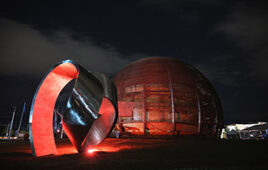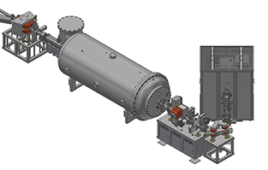Electronic
devices and their components are getting smaller and smaller. Tomi
Ruokola has researched in his doctoral dissertation for the Department
of Applied Physics in Aalto University how the heat generated by
electronic components could be controlled and utilized.
Heat
flows and their control are experimentally thinly researched areas.
Ruokola’s study tackles the basic questions of the field: how heat
transfer occurs from one point to another and how this flow can be
controlled in electronic circuits approaching nano-scale?
“Heat
flows are considerably more difficult to control than electrical
currents. Heat is pure energy, electricity on the other hand is charges
that can be accurately measured. Heat flows are not directly accessible
in the same way, which makes experimental research hard,” explains
Ruokola.
Ruokola
has designed two mesoscopic, in the size scale between macroscopic and
microscopic, devices for heat transport. They are based on
single-electron phenomena: the movement of single electrons through the
constructed system. Electrons carry, in addition to their electrical
charge, an arbitrary amount of heat.
The
smaller the scale of devices and components becomes, the more quantum
level phenomena come to the fore. This requires new ideas and methods
for heat transfer as well.
Together
with researcher Teemu Ojanen of O.V. Lounasmaa Laboratory in Aalto
University, Ruokola developed a single-electron diode, a rectifier,
which allows heat to flow only in one direction and blocks the flow to
the other. The idea comes from the well-known electronic component of a
similar function.
The
flow between different temperatures is normally symmetric: the flow
goes from a hotter point to a cooler one, as the temperatures seek to
balance each other out. If we want to control the flows, we need to
manipulate them to flow in the direction desired. The diodes we present
are ideas for how to come up with a strongly asymmetrical heat flow.
“The diode we developed performed remarkably well compared to existing literature,” says Ruokola.
Groundbreaking applications require experimental research
Ruokola says that basic nano-level research of heat flows is severely held back by a lack of experimental setups.
“The
motivation behind my research was above all the desire and need to
understand the basic phenomena and control of heat transfer and flows,”
says Ruokola. “If the problems in basic research and experimentation
were to be solved, future applications in nanoelectronics would be
outstanding.”
Computers,
he says, could work on heat currents instead of electricity, and the
vast amount of waste heat in server farms could be captured and
converted already on microchip level. Microchips smaller than a
nanometre would also work in room temperature; making use of quantum
level phenomena would not anymore require temperatures approaching
absolute zero.
These are out reach for now, and at least a decade, or decades, away.
Nonetheless,
Ruokola is intrigued by the utilization of waste heat. In the
dissertation he built a thermoelectric heat engine, which puts waste
heat energy back into work. In the engine the charge flows of electrons
doing the work and the heat-transferring flows of photons can be
separated from each other.
“In
heat engines and waste energy the main issue usually is the efficiency
of energy use. However, when there is an abundance of waste heat, the
most crucial thing is not efficiency, but rather the maximum power that
can be extracted from the heat,” Ruokola points out.
As long as there is cold and a hot spot in microchip, the heat flow between them can be put back into the chip as useful work.
In
the diodes the main problem is transferring large currents. In the
single-electron systems built by Ruokola, the currents and power levels
are of course low. Similar systems of high interaction—and with large
currents—would be of great demand.
“These
are the basic issues yet to be solved in heat flow control in
nanoelectronics. There is still a lot do get our heads around in basic
theory,” believes Ruokola.
Tomi Ruokola’s doctoral dissertation is titled “Thermal Transport in Mesoscopic Devices”.
Source: Aalto University




